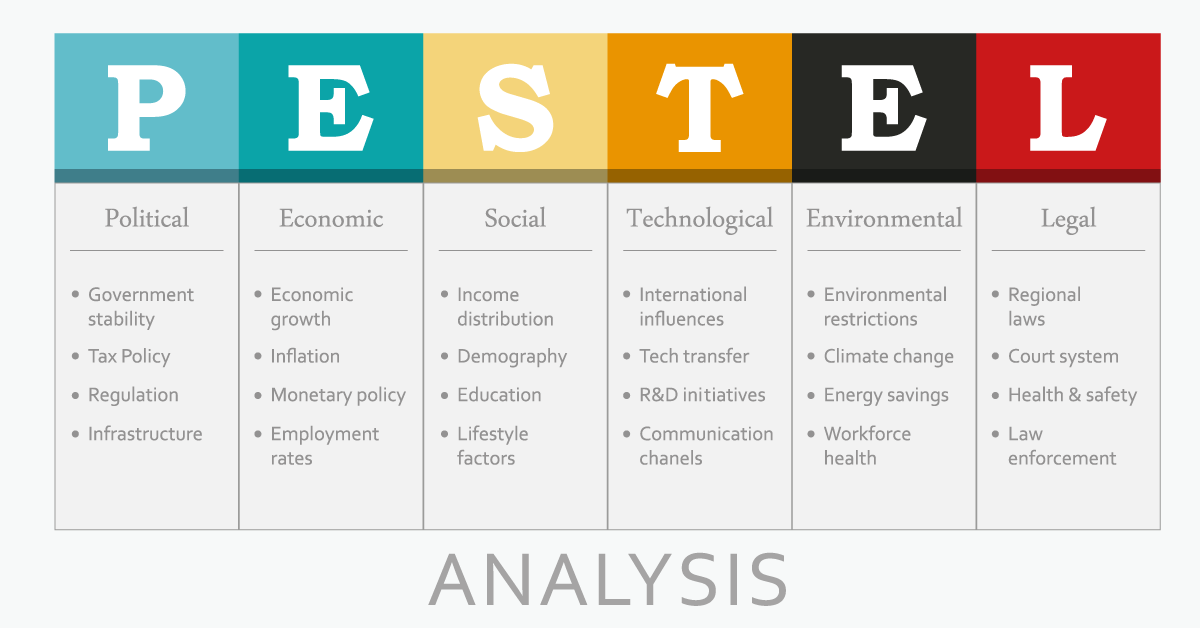For many entrepreneurs, building and driving a business can often feel like a combat: business owners not only need to face adversity and respond to new challenges, but also thrive to master their enterprise. As such, we can learn from the Japanese term “Zanshin”, originated in martial arts, which describes a state of total awareness, of oneself and of its surroundings, in an effortless way. Let’s find out how to do so!
In business, achieving such level of awareness of one’s context demands some effort, nevertheless, modern-day entrepreneurs or entrepreneurs can rely on a very simple and effective tool to strengthen their awareness and analysis of their business context.
Probably the best known and most spread tool is the PESTEL analysis.
What’s the PESTEL Analysis?
Probably the best known and most spread tool is the PESTEL analysis, defined by the Oxford Dictionary as “a management method that examines the effect that events or influences from outside may have on the performance of a company or organization; an analysis tool to help managers identify their market positioning and strengths”. In other words, it could be described as a strategic tool or framework to identify market trends, business status, and potential opportunities or challenges. As such, the PESTEL analysis will provide valuable input into any strategic SWOT analysis.
PESTEL is an acronym which stands for Political, Economic, Social, Technological, Environmental & Legal, covering all aspects or angles within this analytical strategic framework. These 6 categories, that should always be considered over a certain period of time in order to distinguish past tendencies and detect future trends, give a rather complete and complementary 360° scan of the business environment, some aspects will even overlap the same topic (for example political & environmental through CO2 taxation). To demonstrate this, let’s deep-dive into each one of them.
Political
The political aspects to be assessed include the government policies with regards to business, like taxation, trade, labour and environmental laws. Political stability, corruption reputation, but also education system, infrastructure and health regulations can also be considered at this stage to assess the accessibility and attractiveness of a potential market.
Economic
This part of the analysis will focus on indicators of the overall economic performance, prosperity and perspectives in a given market (geographical and/or industry), like business growth rates, unemployment, inflation, interest rates, exchange rate. Further indicators include disposable household income – relevant for B2C markets – and market or industry accessibility.
Social
The social of socio-cultural factors will draw an insightful picture about the general demographic characteristics, norms, customs & values of the social environment, based on factors like population trends (growth, ageing, …), income distribution, views on work, lifestyle & health attitudes and cultural beliefs & barriers. These aspects will allow to gain first marketing insights into customer behaviour and market acceptance.

Technological
This section covers the pace and prospects of technological innovation & development affecting a market or industry, not just in product design of digitalisation, but also with regards to manufacturing, logistics and distribution channels. This part of the analysis not only evaluate the propensity for innovation & development, but also a company’s relative strengths in such areas.
Environmental
Environmental factors relate to the importance of CSR (Corporate Sustainability Responsibility) within the surrounding environment, for example ecological aspects like carbon footprint targets, climate change policy, recycling standards, waste disposal and sustainability of resources. More recently, ethical standards’ influence has risen within this assessment.
Legal
This final part sets the legal framework of laws (antitrust, labour, data protection, intellectual property, health & safety, …) that any business and person needs to comply with. Different from one market to another, and the evolution of laws over time make this a tricky yet crucial aspect of the PESTEL analysis as the consequences can be significant and damaging (both from a financial and an image point-of-view).
To support this systemic approach of a PESTEL analysis, several straightforward and simple templates are available, to help structure the analysis and ensure all key factors and questions are properly addressed.
To summarise
A 360° analysis like PESTEL allow a company identify external factors and assess their impact on the market environment (competition), the growth prospects (customer) as well as the business performance (company).
Understanding these factors and their implications is a crucial step to assess the relative strengths & weaknesses of a business, and the opportunities & threats present in the environment, much as defined by the term “Zanshin” : total awareness, of oneself and its surroundings.
As such, the PESTEL analysis provides relevant and effective insights for a SWOT analysis – which is the logical next step in defining a business strategy ahead of the combat – to be addressed in more detail in a future post.
Are you looking for someone to help you for your PESTEL Analysis?
We can do it!

